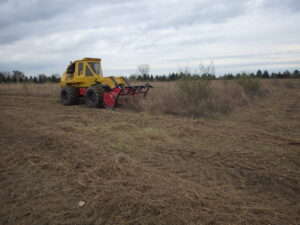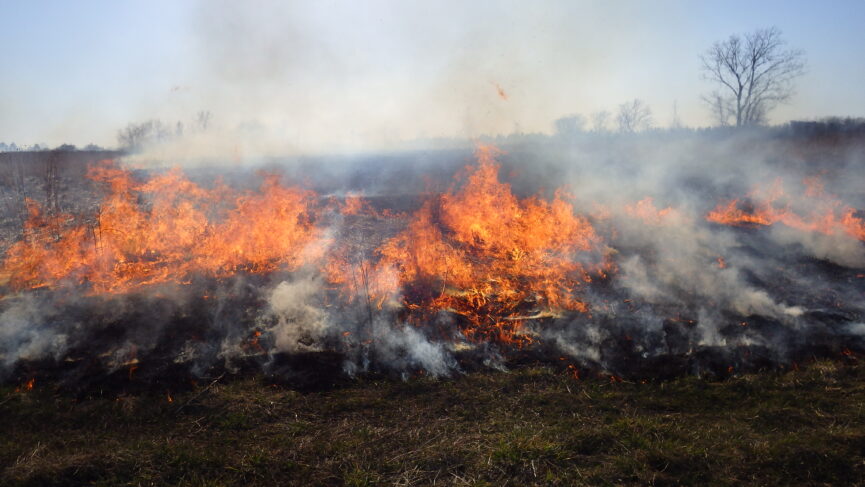
Author’s land near Cass City, MI
The ground my wife Ginny and I started with in 1976 to build our home, was a bare corn stubble field. Entailing 10 acres located at the back of my parents’ farm, a top priority was to establish wildlife covers wherever possible. Because the ground had been treated with herbicide, grass would not get a good start for another 3 years, but it could grow trees and shrubs in good form due to less competition from weeds. Evergreens were at the top of the list, as well as a highly recommended, berry-producing shrub called autumn olive.
Autumn olive hails from eastern Asia and is highly adaptable to a wide variety of soil types as well as being fast growing. It was regarded and touted by government agencies as being ideal for establishing shelterbelts and controlling erosion, and even as a yard ornamental. Of course, I bit right into that “apple”, and along with evergreen trees, I planted autumn olive seedlings obtained from the local NRCS, a lot of them, in establishing a hedge along the border of the trees. I even planted a hedge behind my newly developed farm pond, as well as along part of my driveway.
Yep, folks, it proved to be a “miracle shrub” I much admired, because it worked as advertised, and even on my hard clay, it could create a chest-high, berry-producing hedge in only a couple years, and the birds and other wildlife absolutely loved the ripe berries. The berries are very sweet and edible, possessing a grapelike flavor which can be made into jam. Autumn olive bushes supposedly can reach a maximum height of 11 feet, but I’ve seen them grow much higher and become almost tree-form. I recently cut down an elderly specimen which had a multi-trunk base that was 12 inches across!
I must admit that I really liked autumn olive for over 20 years, and even bragged about it, because it creates amazing wildlife cover which can become nearly impenetrable. I can attest it also has its share of long, sharp thorns which can penetrate even the toughest garments. Besides birds eating the ripe berries, I’ve seen deer enjoying them as well, and I will never forget witnessing an enormous flock of migrating bluebirds feasting away, causing the hedge to be surrounded by a spectacular and moving blue haze! However, once an autumn olive berry passes through a bird’s digestive tract, it has the unique ability to be perfectly “fertile” to create more autumn olive bushes wherever bird droppings land. This is why you see it appearing very prevalent underneath power lines, along fencerows and can make its presence quickly known in woodlands and shelterbelts.
About 25 years ago, autumn olive was declared by government agencies to be an unwanted invasive species, and highly recommended landowners to not plant any. Well, folks, this was the same as closing the barn door after the horse got out, and autumn olive has gained a strong foothold I’m sure is here to stay. This occurred about the same timeframe my wife and I had obtained the rest of the family farm and immediately enrolled the majority into grassland CRP, which includes evergreen shelterbelts around the perimeters. According to the CRP rules, shrubs and other woody plants (trees) are not allowed to proliferate in the grasslands, and allowing such is a violation of the contract.
My goal is to create the perfect habitat for wild pheasants, which in turn promotes all wildlife, including deer, wild turkeys, songbirds and insects such as butterflies and honeybees. This entailed planting warm season prairie grasses and wildflowers which has proven to benefit all the above. However, with a well-established autumn olive presence in nearby cover, I’ve discovered pheasants dearly love to dine on the ripe berries, and it is easy to see where their favorite ground-roosting sites are in the prairie grass fields, because autumn olive clumps, some quite large due to flocks roosting together, will suddenly sprout up. Pheasants always leave droppings in the roost, and hence the perfect storm tends to be continually on the horizon.
I fully support prescribed burns in the spring to refurbish prairie grasslands, as fire is nature’s way of properly handling matters by removing thatch, destroying weeds and brush, as well as adding nutrients to the soil. Watching a charred-black field after a prescribed burn is amazing, because green quickly starts showing, soon followed by a maze of wildflowers and the prairie grass comes back with gusto! I’ve seen it reach over six feet tall by August, providing the perfect wintertime habitat for pheasants and other wildlife.
However, after over 20 years’ experience, I’ve discovered autumn olive, especially if it has developed a sound root structure, is very fire-resistant, and requires a lot of high and extended heat to succumb. Grassfires tend to move rapidly, and although they eliminate most woody substances, autumn olive hardly blinks and may still have newly formed green leaves showing, as well as more will appear, even out of a supposedly charred exterior. Yep, folks, it is a very rugged “miracle plant”!
About 3 years ago, I received a letter from the local FSA informing me that I had an established autumn olive presence in my south field which needed to be addressed, and I had no argument. I contacted Kappen Tree Service and requested them to take care of matters with their “Masticator” on tracks, during the winter. Since autumn olives had inundated the field, I requested that the entire field be done, because doing a “spot-job” was ridiculous. The masticator features carbide teeth which remove the thatch and grinds up everything, including all woody substances, into a fine mulch which is spread evenly. A nickname I’ve dubbed this machine is the “emasculator” because it literally neuters autumn olive by grinding down into the root collar. I would discover the benefits in its refurbishing the prairie grass was nearly identical to that of a prescribed burn, minus the predictable revitalization of mature autumn olives.
I now have 3 separate fields in the CRP SAFE program, and my north field had to be done last fall to meet mid-management regulations, and I called upon the service of Kappen’s masticator, due to a widespread autumn olive infestation. The middle and south fields were required to be done this spring, and the middle field was recently done with a masticator, with the south field being prescribed burned (by Firepros, LLC of Clifford), because the only autumn olive in it was younger plants coming up from seed and are more susceptible to fire. My goal is to compare how the fields refurbish themselves according to the method used.
Autumn olive is also quite herbicide-resistant, usually requiring harsh chemicals to effectively kill it, something I had rather avoid. I’ve discovered when you must do battle with autumn olives on a large scale, the masticator works for me. Although it is a tad more costly, I want to do matters right, as it is my goal to have the best conservation cover, I can create on my ground.
Time will tell, and I’m really curious about the final results of my experimental comparison.
- Summertime plinking while dealing with the “red menacing horde “ - July 16, 2024
- Ladies Preparing To Take Aim - June 23, 2024
- The magical atmosphere of fishing during the “Dog Days” of summer - June 17, 2024

